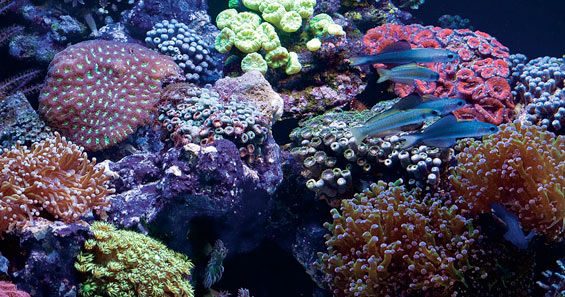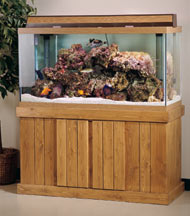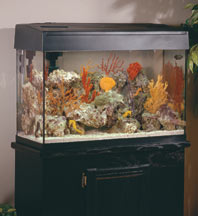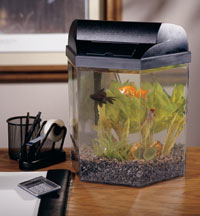
No single aquarium is right for everyone, so you need to take some factors into account when choosing one that is right for your home or office.
Keeping a successful aquarium depends greatly on the time you spend researching the correct set-up for the fish you choose to house. LiveAquaria.com is a great place to research the habitat requirements of fish you find attractive or interesting. As you learn more about the kinds of fish species you can house together, you will need to consider certain aquarium decisions, such as:
- Location
- Size
- Construction
 Location, location, location
Location, location, location
Set up your aquarium where you spend most of your time
This way, you can fully enjoy the results of your endeavor. An aquarium placed in a back room or basement often does not get the care or attention it needs, increasing the risk of fish disease and filter malfunctions. So choose a room where you will not only be able to view and enjoy your system, but also maintain it properly. Remember, once an aquarium is set up, it weighs at least 10 times your tank's water capacity, and it must be disassembled to properly move it again. You must totally tear it down, which can be very stressful on fish. So, choose the location carefully, and keep the following considerations in mind.
Your aquarium needs a "space bubble"
Just as people need adequate space around them, your aquarium needs sufficient space around it for cleaning and maintenance. Select an area that will not block accessories you need access to, such as the back of the aquarium for filtration and the top of the aquarium for water changes and lighting. If placing it in an enclosed area, make sure that it has adequate ventilation. This helps control mold and other cultures that thrive in humidity and keeps heat build-up to a minimum. Keeping a cover on the aquarium will also help keep humidity levels down and decrease the amount of water you need to replace due to evaporation.
Is an electrical outlet, and a water source, within close distance?
Electric outlets need to be close enough that you can plug in a strip outlet without having extra cord in the way to become a tripping hazard (no more than 3' is best). In addition, the closer your water supply, the easier your water changes and other maintenance, helping you keep a healthier aquarium.
Are heat/AC vents or outside entrances nearby?
Heating and air conditioning vents, as well as outside entrance areas, have the ability to drastically change the temperature of the immediate area, including your aquarium. A stable water temperature is imperative to a healthy aquarium, so make sure to place your aquarium away from these areas. Also, it is very important to keep your aquarium out of direct sunlight. This will help prevent algae growth as well as high temperatures.
 Will your aquarium stand set stable and level?
Will your aquarium stand set stable and level?
Check the floor in the area you wish to place your aquarium to see if it gives under your weight and whether the flooring is level. If part of the stand is on a hard surface, such as a hardwood floor, and the other is on a soft surface, such as padded carpeting, you'll need to check the level with weight on the stand. If it is not level, it is possible to use a shim to make up for a small difference on all but large aquariums. A surface that isn't level not only makes it impossible to totally fill your aquarium, but it may be a hazard because your aquarium might easily tip over.
Size Limitations
What's the best size?
The minimum size you should consider is the minimum size your inhabitants will thrive in. If you are not able to provide at least that size, it's best to pick another fish. The bigger the aquarium, the better it is for the fish within it. Larger water volume dilutes toxins better, making it more forgiving of mistakes. Also, larger aquariums cycle faster, making for a shorter stress period on fish.
Will the floor be able to withstand the weight?
Here's the tricky part for medium to large aquariums. Most flooring is intended to hold humans and their furniture. Normally, a 30-gallon aquarium weighing 300 lbs. is probably no problem, especially against a weight bearing wall, but if considering anything larger, you'll want to verify with a professional that your flooring is capable of supporting it. The weight your flooring can support is figured in pounds per square foot, or psf.
 To figure the psf of the aquarium you are considering, find its total weight by multiplying its gallon size by 10 (55 gallons x 10 = 550 lbs.). Next, divide total weight by the square-foot floor space (footprint) it uses. For example, a 55-gallon tank with a weight of 550 lbs. that uses 4 sq. ft. of floorspace (4' x 1'), exerts 137.5 psf (550 lbs. divided by 4 sq. ft.). Larger gallon-size doesn't always mean more psf weight. Generally, the more the weight can be spread out, the less psf you're exerting on your floor. Consider this: a 120-gallon tank that has a 4' x 2' footprint (8 sq. ft.) can weigh 1,200 lbs. and exert 150 psf, whereas a 125-gallon that has a 6' x 1.5' footprint (9 sq. ft.), could weigh 1,250 lbs. and exert less than 140 psf.
To figure the psf of the aquarium you are considering, find its total weight by multiplying its gallon size by 10 (55 gallons x 10 = 550 lbs.). Next, divide total weight by the square-foot floor space (footprint) it uses. For example, a 55-gallon tank with a weight of 550 lbs. that uses 4 sq. ft. of floorspace (4' x 1'), exerts 137.5 psf (550 lbs. divided by 4 sq. ft.). Larger gallon-size doesn't always mean more psf weight. Generally, the more the weight can be spread out, the less psf you're exerting on your floor. Consider this: a 120-gallon tank that has a 4' x 2' footprint (8 sq. ft.) can weigh 1,200 lbs. and exert 150 psf, whereas a 125-gallon that has a 6' x 1.5' footprint (9 sq. ft.), could weigh 1,250 lbs. and exert less than 140 psf.
Once you know the psf rate of your flooring, and the amount of space you have available, this will determine the maximum aquarium size you can consider.
Glass or Acrylic
Another important question that must be asked in an aquarium purchase is whether to choose glass or acrylic. Depending on your lifestyle and décor needs, it may be helpful for you to know that glass aquariums tend to be less expensive and more scratch-resistant. Conversely, acrylic aquariums are less scratch-resistant, but they are considered stronger than glass and less inclined to break. If you move often, you'll also appreciate their lighter weight. In geographic areas where earthquakes are common, acrylic is more forgiving of the shifting. Although glass does not scratch as easy as acrylic, acrylic scratches can be repaired. Also consider your aesthetic desires; acrylic is a more pliable material than glass, so it can be formed into more interesting shapes.
More Than One?
After learning all about your favorite fish species, it's highly unlikely they can all co-exist in the same aquarium. Down the road, you may wish to consider another aquarium. Aquarium Kits make it easy to get everything you need. Smaller Desktop Aquariums feature compact design making them a wonderful choice for a child's room. It's a great way to teach children about the beautiful life that exists in an aquatic ecosystem. |






